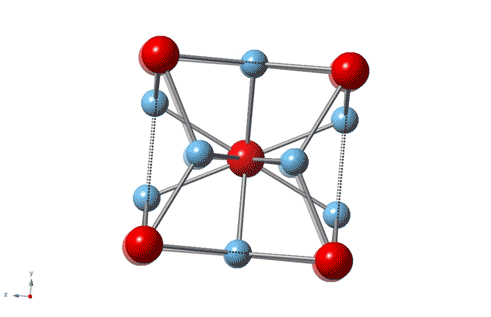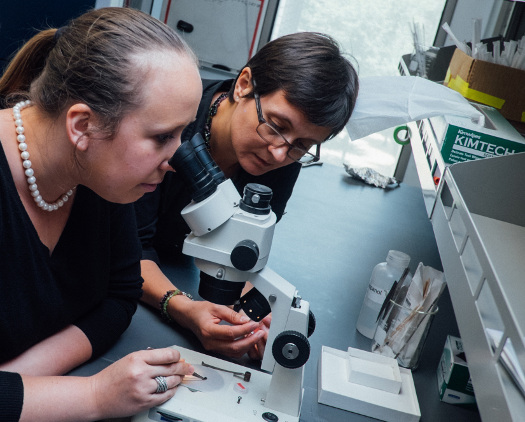 |
| August 02, 2016 | Volume 12 Issue 29 |
Designfax weekly eMagazine
Archives
Partners
Manufacturing Center
Product Spotlight
Modern Applications News
Metalworking Ideas For
Today's Job Shops
Tooling and Production
Strategies for large
metalworking plants
Titanium-gold alloy 4x harder than most steels
Titanium is the leading material for artificial knee and hip joints because it's strong, wear-resistant, and nontoxic, but an unexpected discovery by Rice University physicists shows that the gold standard for artificial joints can be improved with the addition of some actual gold.
"It is about three to four times harder than most steels," said Emilia Morosan, the lead scientist on a new study in Science Advances that describes the properties of a 3-to-1 mixture of titanium and gold with a specific atomic structure that imparts hardness. "It's four times harder than pure titanium, which is what's currently being used in most dental implants and replacement joints."

Crystal structure of beta titanium-3 gold.
Morosan, a physicist who specializes in the design and synthesis of compounds with exotic electronic and magnetic properties, said the new study is "a first for me in a number of ways. This compound is not difficult to make, and it's not a new material."
In fact, the atomic structure of the material -- its atoms are tightly packed in a "cubic" crystalline structure that's often associated with hardness -- was previously known. It's not even clear that Morosan and former graduate student Eteri Svanidze, the study's lead co-author, were the first to make a pure sample of the ultrahard "beta" form of the compound. But due to a couple of lucky breaks, they and their co-authors are the first to document the material's remarkable properties.
"This began from my core research," said Morosan, professor of physics and astronomy, of chemistry, and of materials science and nanoengineering at Rice. "We published a study not long ago on titanium-gold, a 1-to-1 ratio compound that was a magnetic material made from nonmagnetic elements. One of the things that we do when we make a new compound is try to grind it into powder for X-ray purposes. This helps with identifying the composition, the purity, the crystal structure, and other structural properties.
"When we tried to grind up titanium-gold, we couldn't," she recalled. "I even bought a diamond (coated) mortar and pestle, and we still couldn't grind it up."
Morosan and Svanidze decided to do follow-up tests to determine exactly how hard the compound was, and while they were at it, they also decided to measure the hardness of the other compositions of titanium and gold that they had used as comparisons in the original study.
One of the extra compounds was a mixture of three parts titanium and one part gold that had been prepared at high temperature.

Eteri Svanidze (left) and Emilia Morosan. (Photo by Jeff Fitlow/Rice University)
What the team didn't know at the time was that making titanium-3-gold at relatively high temperature produces an almost pure crystalline form of the beta version of the alloy -- the crystal structure that's four times harder than titanium. At lower temperatures, the atoms tend to arrange in another cubic structure -- the alpha form of titanium-3-gold. The alpha structure is about as hard as regular titanium. It appears that labs that had previously measured the hardness of titanium-3-gold had measured samples that largely consisted of the alpha arrangement of atoms.
The team measured the hardness of the beta form of the crystal in conjunction with colleagues at Texas A&M University's Turbomachinery Laboratory. At the National High Magnetic Field Laboratory at Florida State University, Morosan and Svanidze also performed other comparisons with titanium. For biomedical implants, for example, two key measures are biocompatibility and wear resistance. Because titanium and gold by themselves are among the most biocompatible metals and are often used in medical implants, the team believed titanium-3-gold would be comparable. In fact, tests by colleagues at the University of Texas MD Anderson Cancer Center in Houston determined that the new alloy was even more biocompatible than pure titanium. The story proved much the same for wear resistance: Titanium-3-gold also outperformed pure titanium.
Morosan said she has no plans to become a materials scientist or dramatically alter her lab's focus, but she said her group is planning to conduct follow-up tests to further investigate the crystal structure of beta titanium-3-gold and to see if chemical dopants might improve its hardness even further.
Additional co-authors include Pulickel Ajayan, Sruthi Radhakrishnan, and Chandra Sekhar Tiwary, all of Rice; Tiglet Besara, Yan Xin, Ke Han, and Theo Siegrist, all of Florida State; Fevzi Ozaydin and Hong Liang, both of Texas A&M; and Sendurai Mani of MD Anderson. The research was supported by the National Science Foundation, the Department of Energy, Texas A&M's Turbomachinery Laboratory, and the Florida State University Research Foundation.
Source: Rice University
Published August 2016
Rate this article
View our terms of use and privacy policy
